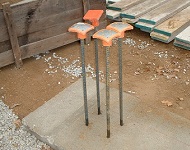
By Gregory Havel
Any response to a construction job site exposes emergency workers to hazards that are not common in finished buildings. Among these hazards are access problems, temporary lighting that would be considered inadequate by the building code in a completed building, temporary storage of materials, liquid and gaseous fuels, housekeeping issues, trip and fall hazards, and impalement hazards.
Impalement hazards can be especially dangerous because of poor visibility. The most common impalement hazard is the steel bar (rebar) that is used to reinforce concrete.
The Occupational Safety and Health Administration (OSHA) in 29 CFR 1926.701(b) requires that the exposed ends be covered with a metal-reinforced cap (photo 1), lumber at least 1½ inches thick, or other protection for workers against injury by cuts or by impalement from falls. In poor lighting or dusty conditions or in the glare of bright sunlight, rebar can blend into the background of concrete and concrete block.
(1) Photos by author.
Rebar is installed vertically in footings (photo 2) to reinforce the foundation walls that will be built on them. These rebar often extend upward from the footings through the cores of the concrete block wall to the bearing plates for beams, girders, or joists at the top of the wall. At any time that workers could be exposed to the hazard of cuts or impalement on rebar, the ends are supposed to be capped (as they are in the photos) or otherwise protected.
(2)
Rebar is also installed horizontally in footings, in foundations, in poured concrete walls, and in “bond beams” (photo 3) in concrete block walls. If rebar ends are properly protected, tripping and landing on them will not cause impalement, but it can still leave a nasty bruise. In photo 3, the rebar in the lower bond beam is capped properly. In the upper bond beam, the rebar will have to be capped before additional work begins in that area.
(3)
Although rebar is the most common impalement hazard at a construction site, it is not the only one. Others include any kind of stored material or equipment and pipes stubbed out of completed walls in unexpected places. Photo 4 shows the water supply and waste pipes for the plumbing in a school washroom. Although only the most rigid of these pipes and mounting bolts could cause impalement, the rest can still cause bruises, abrasions, and other injuries if someone falls against them.
(4)
The OSHA regulations state, “All protruding reinforcing steel, onto and into which employees could fall, shall be guarded to eliminate the hazard of impalement.” [29 CFR 1926.701(b)]
The OSHA regulations also state, “During the course of construction, alteration, or repairs, form or scrap lumber with protruding nails, and all other debris, shall be kept clear from work areas, passageways, and stairs, in and around building or other structures.” [29 CFR 1926.25(a)]
Other impalement hazards not specifically mentioned in the OSHA regulations, such as protruding pipes, bolts, reinforcing wire, and cables are considered covered under the “General Duty Clause” [Section 5(a)(1)] of the Occupational Safety and Health Act, which states “Each employer shall furnish to each of his employees employment and a place of employment which are free from recognized hazards that are causing or are likely to cause death or serious physical harm to his employees.” Under this section of the Federal Statute, OSHA can and does cite and fine employers for unsafe conditions on construction job sites that are not specifically mentioned in the Code of Federal Regulations (CFR). OSHA also has letters of interpretation that were requested by employers to clarify terms and situations.
OSHA regulations can be viewed and printed at no cost at www.osha.gov. Click on “Regulations” >> “OSHA Law and Regulations” >> “Construction.”
To view the regulation concerning rebar as an impalement hazard, scroll down to view 1926.701 and click on the link. Scroll down to “701(b).” This is hyperlinked, and will open a Web page listing all of OSHA’s Letters of Interpretation that have been issued regarding rebar and impalement hazards.
Use extra caution any time you are called to an incident at a construction or remodeling job site. If you are working on the interior, carry hand lights to ensure that you can clearly see where you are going or if the temporary lighting should go out. Also ask the general contractor or construction manager for an escort to guide us on the shortest and safest route to the incident.
Download this article as a PDF HERE (422 KB)
 Gregory Havel is a member of the Town of Burlington (WI) Fire Department; retired deputy chief and training officer; and a 35-year veteran of the fire service. He is a Wisconsin-certified fire instructor II, fire officer II, and fire inspector; an adjunct instructor in fire service programs at Gateway Technical College; and safety director for Scherrer Construction Co., Inc. Havel has a bachelor’s degree from St. Norbert College; has more than 35 years of experience in facilities management and building construction; and has presented classes at FDIC.
Gregory Havel is a member of the Town of Burlington (WI) Fire Department; retired deputy chief and training officer; and a 35-year veteran of the fire service. He is a Wisconsin-certified fire instructor II, fire officer II, and fire inspector; an adjunct instructor in fire service programs at Gateway Technical College; and safety director for Scherrer Construction Co., Inc. Havel has a bachelor’s degree from St. Norbert College; has more than 35 years of experience in facilities management and building construction; and has presented classes at FDIC.
MORE CONSTRUCTION CONCERNS
-
Connections: Lightweight Steel Trusses
- Structural Steel—Riveted Connections
-
Skylight Roof Panels
-
Timber Connections
- Appearance
-
Pre-Code Buildings
- Classification of Flammable and Combustible Liquids
- Job Site Fire Safety
- Natural Gas and Propane

